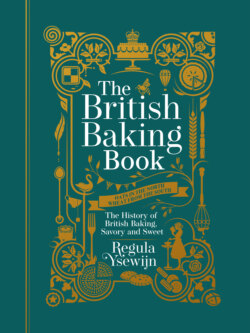Читать книгу The British Baking Book - Regula Ysewijn - Страница 48
На сайте Литреса книга снята с продажи.
ОглавлениеTottenham cake
51
For 12 portions
For the cake
1 cup + 5 Tbsp (300 g) butter, at room
temperature
1½ cups (300 g) granulated white sugar
6 eggs
4 cups (500 g) plain white flour
3 Tbsp + 1 tsp (50 g) baking powder
¹⁄
³
cup milk
butter, for greasing
flour, for dusting
For the icing
3 cups (350 g) confectioners’ sugar
2 Tbsp red currant juice or water
natural pink coloring (if you don’t use
red currant juice)
desiccated coconut and/or “hundreds
and thousands” sprinkles, to garnish
(optional)
For a 9½ x 11–inch cake tin
Preheat your oven to 325°F and prepare the cake tin (see page 21).
Put the butter and granulated sugar in a bowl and beat until creamy. Add the eggs,
one at a time, and make sure that each egg is completely incorporated before
adding the next one. Add a teaspoon of the flour with the last egg to prevent the
mixture from separating.
Carefully fold the remaining flour and the baking powder into the batter so that
the volume is retained. Stir in the milk, a little at a time. Spoon the batter into
the tin and smooth the top. Bake in the middle of the oven for 30–40 minutes.
Allow the cake to cool completely.
For the icing, mix the confectioners’ sugar with the red currant juice or the water
and the pink coloring.
Put the coconut and/or sprinkles in a shallow bowl. Trim the cake edges. You can
freeze the trimmings for filling Banbury cakes (see page 134). Spread the cake
with the icing and cut it into 12 pieces, wiping the knife after each cut. Dip the
cake pieces into the coconut or sprinkles or just leave them plain.
It is best to eat this cake on the day it’s made or the following day.
In 1901, pieces of Tottenham cake were given away to children from the London neighborhood of Tottenham to
celebrate the victory of the Tottenham Hotspurs in the FA Cup. The pink icing is traditionally colored with mulberry
juice, and sometimes the cake is finished with “hundreds and thousands” sprinkles or desiccated coconut.
John Kirkland writes in The Modern Baker, Confectioner and Caterer that this is an easy and quick cake for children’s
parties and other occasions for which many pieces must be baked in a short time. His recipe is for a giant cake that is
made with more than eleven pounds of flour, but it is not tasty at all because it contains no egg and almost no sugar and
butter. It clearly had to be cheap to make! The version that I give here is the version that is still sold today – a simple
cake, but also delicious.
“For one penny piece, soft sponge could be bought,
mis-shapen, a ha’penny, a feast that was sought.
Pink icing with colour from mulberry so red,
So sticky, delicious, the people were fed …”
“Tottenham Cake,” by Henry Jacobs
